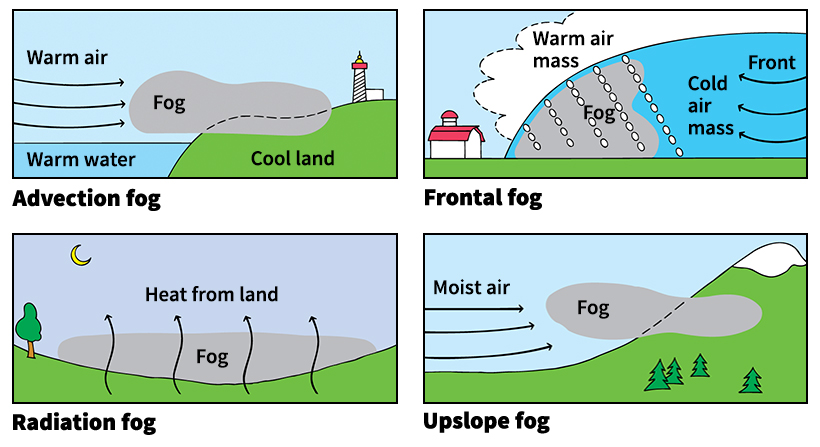Fog is a collection of tiny water droplets that float in the air. Fog is similar to clouds, except that clouds do not touch the earth’s surface, as fog does.
Fog forms from water that has evaporated from lakes, oceans, and rivers, or from moist soil and plants. This evaporated water, called water vapor, expands and cools as it rises into the air. Air can hold only a certain amount of water vapor at any given temperature. This amount is called the holding capacity. As the temperature of the air decreases, so does its holding capacity. When the temperature drops so that the amount of water vapor in the air exceeds the holding capacity, some of the water vapor begins to condense (change into small droplets of water). Fog disappears when the air temperature rises and the holding capacity increases. According to international definition, fog is any condensation that reduces visibility to less than 1 kilometer (3,281 feet). Fog that does not greatly reduce visibility is called mist or haze.
There are four main kinds of fog: (1) advection fog, (2) frontal fog, (3) radiation fog, and (4) upslope fog.

Advection fog develops from air traveling over a surface of a different temperature. One kind of advection fog, called sea fog, occurs when warm, moist air travels over a cold surface. Sea fog is most common along seacoasts and lakeshores. Another kind of advection fog, called steam fog, results from cold air passing over warm water. Water vapor, evaporating continuously from the water surface, comes into contact with the cold air. When the air reaches its holding capacity, the excess water vapor condenses quickly into fog droplets that steam up from the water surface. Steam fog commonly appears on cold winter days over the Great Lakes and over warm lakes in Florida.
Frontal fog forms along a front. A front is a boundary between two air masses of different temperatures. Frontal fog is produced when raindrops fall from the warmer air mass into the colder one, where they evaporate. They thereby cause the water vapor in the cold air to exceed the air’s holding capacity.
Radiation fog occurs on calm, clear nights as the ground loses warmth through radiation into the air. A layer of fog forms along the ground, gradually becoming denser. Radiation fog is most common in the San Joaquin Valley in California and in other deep valleys.
Upslope fog develops when moist air moves upward along sloping terrain. The air cools as it moves up the slope until it can no longer hold the water vapor. Fog droplets then form along the slope.
See also Cloud; Condensation; Dew; Smog; Water.
